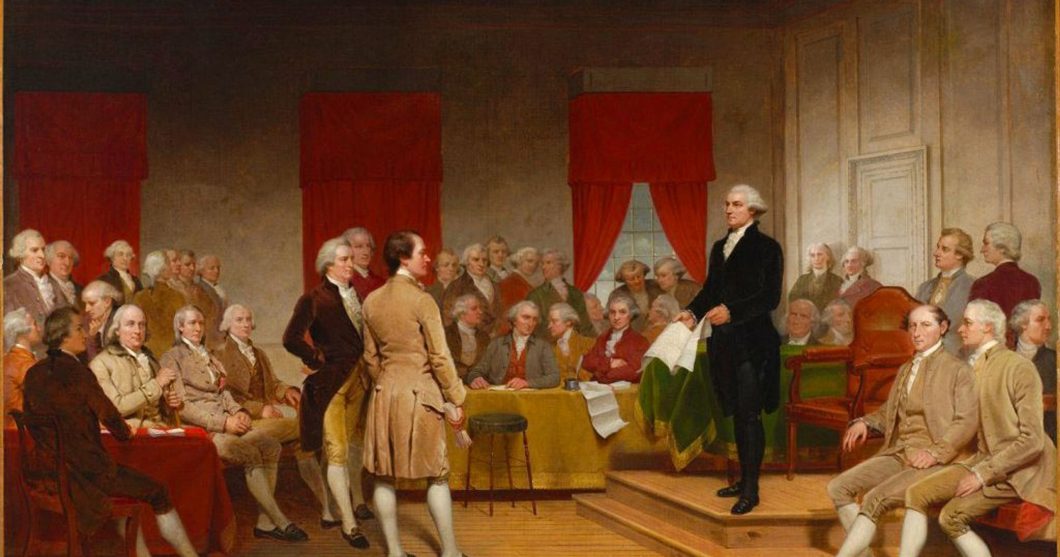Written Constitutions for the World
Only since the 18th century have written constitutions laid out the structure of governments and the fundamental laws governing them. They differed sharply in both form and function from written legal codes since early antiquity and formed states in new ways by putting the law into the hands of ordinary people. Even the illiterate could understand a document read aloud. While constitutions all too often delivered less than what they had promised, the promise itself changed relationships within societies. Rulers and ruled alike saw those documents as tools enabling the state to mobilize resources, manpower, and loyalty amidst crisis in return for private rights and protections for individuals and civil society.
Linda Colley, a distinguished historian of 18th-century Britain, traces this global story in The Gun, the Ship and the Pen: Warfare, Constitutions and the Making of the Modern World. The rising scale and pace of warfare from the 1750s challenged states to adapt or decline. Colley describes written constitutions and other governing documents as a literary form responding to the challenge. Like the novel, she argues, constitutions tell the story of a place and people. They also functioned as “bargains on paper,” legitimating rule to form empires as well as nations. Written constitutions readily spread beyond the European-derived cultures to Africa and Asia. Looking at what she calls “a few big moments in favored sites of action,” like the Philadelphia convention in 1787, Colley adopts a global and historical perspective on the emergence of written constitutions as tools by the state to enable its power.
The United States may have the most studied written constitution in history, but Colley starts before its framing with the problems created by “hybrid warfare” that combed large-scale operations at sea and by land. The Seven Years War (1756-63) marked a turning point as the first global conflict with campaigns in Europe, Asia, and North America. Hybrid warfare gave its practitioners a qualitative advantage, but one that came at a high cost given the massive expense to build ships, support fleets, and raise larger armies for distant operations. Consequent financial strains became a factor in later revolutions as Britain and Spain provoked colonial resistance with new taxes and France lurched into insolvency by 1789.
At the same time, war gave written documents more prominence in governance. Collecting and systematizing information made territories governable by their rulers in a process that reflected Enlightenment rationalism, a process James C. Scott detailed in his book Seeing Like a State. States created new schemes to integrate new colonies with existing territories and set plans for legal reform. Programs to restructure governance in the British and Spanish empires during the 1760s famously brought resistance, but other efforts consciously sought to justify change. Colley cites the Nakaz or Governing Instruction written by Catherine II of Russia as an example that reflected its author’s quest for legitimacy. Publishing translations made the Nakaz an influential subject for debate. Male rulers like Frederick II of Prussia and Sweden’s Gustav III also made written attempts at reform. Gustav III’s Form of Government in 1772 amounted to a constitution by royal decree. Such initiatives, Colley argues, gave the word constitution a new political meaning.
Older documents also shaped Anglophone debate as Magna Charta, originally drafted in 1211, emerged as a guarantee of liberties in the 1750s. Colonial charters served a similar purpose across the Atlantic where colonists guarded them jealously. Unlike Magna Charta, however, those charters established a written form of government. Familiarity with them made a written constitution an easy step for Americans.
The United States Constitution, as Colley notes, shaped what people thought a constitution should be. Delegates who wrote it drew on their experience with military affairs and war finance to bind the states together into a nation to secure the fragile independence they had won. Print put the Constitution into the hands of citizens who claimed it as their own. A protracted ratification campaign amplified this effect as copies circulated widely, along with other texts like the Federalist essays. These documents, like earlier ones during the War for Independence, made a public case for the American Republic. Other states copied not only the structure and ideas, but also publicity techniques in a testimony to American influence.
Napoleon showed during his ascendancy how outsiders could use constitutions to reconfigure, improve, and regulate other parts of the world. Enthusiasts joined statesmen and officials in constitution writing as their task requires little more than pen, paper, and a quiet space to work. What had begun among Protestant societies spread to Catholic ones. The widely translated Spanish constitution of Cadiz functioned as a beacon of enlightened possibilities even after its suppression by Ferdinand VII. Colley describes this alternative to Napoleon’s as a brand of constitutionalism that Latin America later adopted in its independence movements.
Written or not, how well constitutions last over the long term marks the real measure of success—that’s no myth, patriotic or otherwise.
Britain, however, resisted demands for a written constitution because after the 1600s, it stood unusually immune to the pressures of war and upheaval that created them. Constitutional history from the 1820s through the 1920s took its place in a role that partly explains history’s importance to British culture. Parliamentary sovereignty and the flexibility of an unwritten constitution withstood demands to formalize the system into a document. Prosperity and relative peace made the case for the British exception, but, as a center for refugee intellectuals, 19th century London was still an engine for constitution writing by exiles who tried to carry lessons back to their own lands.
Constitutionalism reached beyond Europe to other parts of the world. Polities with recognizable governments and social organizations and with access to print culture fared better than nomadic counterparts. Settlers imposed their own vision on sparsely populated areas and marginalized natives in Australia and California. Constitutions helped them secure autonomy from metropolitan control and often included more egalitarian provisions adopted later elsewhere. These examples provided models for very different societies even as another cycle of warfare during the 1860s forced the pace of change. For instance, revisions to the American constitution after the Civil War expanded federal power and reframed the bargain with citizens in ways overseas commentators followed closely.
Japan’s Meiji Constitution of 1889 also marks a turning point for Colley. Japan’s adoption of a written constitution had been part of a larger modernization project that made the country a rising power. The Meiji Constitution provided the Japanese state the centralized authority needed to secure internal control and resist foreign incursion. Ordinary Japanese shared pride in their country’s rise while other non-Western and non-white societies looked to it as a model. Victory in the 1905 Russo-Japanese war reinforced the association of written constitutions with a strong modern state that could overcome uncompetitive rivals.
What lessons does the story hold? The medieval emergence of representative institutions and the later development of bureaucratic absolutism in the 1600s offer revealing parallels in European history. Each era involved a similar dynamic of challenge and response as military demands forced rulers to adapt. Representative institutions variously called parliaments, estates, and diets gave social groups, including clergy, peasants, nobles, and townsmen, participation in governance to get the community to support royal policy. Bureaucratic absolutism emerged, particularly in 17th century France, to raise funds and manpower. At the same time, the rise of written constitutions highlighted how the dynamic of challenge and response to the state drove events, albeit in different ways depending on circumstance. Print culture’s expanded and the completion of an administrative revolution shaped by it helped spread written constitutions as a new form.
Colley describes herself as “a candid friend” to written constitutions, having first encountered them coming to the United States from her native Britain. That phrase, as she doubtless recognizes, evokes George Canning’s wish to be spared equivocal “friendship” masked by candor in his poem New Morality. Better the avowed and open foe whose charge can be met and perhaps refuted than a surreptitious blow. Colley’s conclusion asking what kind of overwhelming emergency might call experts to revise and amplify the US Constitution strikes exactly that note of less than friendly candor. She notes that the current political dysfunction might spring from a document too old and too limited for the present day. Her point echoes long-standing arguments by American progressives that the Constitution impedes changes needed to achieve social democracy, racial equity, and effective technocratic governance. She ignores the argument of other Americans that these supposed “impediments” are a key feature securing liberties; protect a balance of interest within an extensive, continental republic; and furnish democratic accountability.
Indeed, the idea that political institutions and traditions can be readily dismantled and reforged without unleashing wider consequences reflects a discredited outlook shaped by deconstructionist theory. It gained ascendancy within the academy during the 1980s and 90s before extending its reach into public culture, but the subsequent failure of various nation or state-building projects shows its limitations. Colley makes a strong case for understanding constitutions as products of their time and circumstances. Her observation that they take on a life of their own conveys more than she may intend. Implementation shapes how constitutions work and how they often adapt without formal amendment or revision. They shape the actions of people just as they are shaped by the people themselves. Written or not, how well constitutions last over the long term marks the real measure of success—that’s no myth, patriotic or otherwise.


